Abstract
Egypt must present a more thorough and accurate picture of the state of the air, as this can contribute to better environmental and public health results. Hence, the goal of the current study is to map and track the spatiotemporal air quality over Egypt’s Qena Governorate using remote sensing data. The current investigation is considered a pioneering study and the first attempt to map the air quality index in the studied area. Multisource remote sensing data sets from the Google Earth Engine (GEE) were used to achieve this. The first is Sentinel-5P’s average annual satellite image data, which were gathered for four important pollutants: carbon monoxide (CO), sulfur dioxide (SO2), nitrogen dioxide (NO2), and ozone (O3) over a six year period from 2019 to 2024. The second is the MODIS aerosol optical density (AOD) product satellite image data from the GEE platform, which calculate the average annual particulate matter (PM2.5 and PM10). All mentioned pollutant images were used to calculate the air quality index (AQI) and aggregated air quality index (AAQI). Lastly, we used Landsat’s average yearly land surface temperature (LST) retrieval (OLI/TIRS). The aggregated air quality index (AAQI) was computed, and the U.S. Environmental Protection Agency’s (USEPA) air quality index (AQI) was created for each pollutant. According to the data, the AQI for CO, PM2.5, and PM10 in the research region ranged from hazardous to unhealthy; at the same time, the AQI for NO2 varied between harmful and unhealthy for sensitive groups, with values ranging from 135 to 165. The annual average of the AQI for SO2 throughout the studied period ranged from 29 to 339, with the categories ranging from good to hazardous. The constant AQI for ozone in the study area indicates that the ozone doses in Qena are surprisingly stable. Lastly, with a minimum value of 265 and a maximum of 489, the AAQI ranged from very unhealthy to dangerous in the current study. According to the data, the area being studied has poor air quality, which impacts the environment and public health. The results of this study have significant implications for environmental sustainability and human health and could be used in other areas.
1. Introduction
For the sake of sustainable agriculture and global food security, global efforts should be made to improve air quality [1]. The main environmental issues that many cities face are air pollution from growing populations, traffic, industry, and burning biomass in agriculture, as well as particulate matter from natural sources like dust and sand events and man-made fuel consumption in industry and transportation [2]. Furthermore, respiratory and cardiovascular disorders are among the major health issues that might result from excessive concentrations of several air contaminants [3]. Egypt is among the emerging nations that struggle with air pollution [2,4,5,6]. Particulate matter (PM2.5, PM10), sulfur dioxide (SO2), nitrogen dioxide (NO2), ozone (O3), methane (CH4), formaldehyde (CH2O), and carbon monoxide (CO) are among the most prevalent air pollutants [7]. The term “air quality management” describes all of the actions taken by a regulatory body to assist with shielding the environment and public health from the damaging impacts of air pollution. Setting goals for air quality, reducing emissions, creating control methods, and putting those plans into action are all parts of the process of controlling air quality. To determine if the air quality objectives are being fulfilled, it is critical to conduct ongoing evaluations (https://www.epa.gov/air-quality-management-process/air-quality-management-process-cycle) (accessed on 2 January 2025).
The use of satellite-based remote sensing has gained popularity recently as a potent instrument for monitoring and assessing air quality. Compared to conventional monitoring approaches, remote sensing techniques enable the collection of data on air pollution over both spatial and temporal patterns, thereby yielding a more thorough understanding of air quality [8]. For technical purposes, the Sentinel-5P TROPOMI tropospheric monitoring instrument is used to measure anthropogenic emissions and develop methods for reducing air pollution [9].
Atmospheric substances like NO2, SO2, CO, and CH2O are of particular importance because they have historically and presently been released in significant quantities in urban and industrial regions [10]. Google created the free web-based computing platform known as Google Earth Engine (GEE) to make processing geographical information easier [11]. The algorithms, quick modeling, and visualization are supported by this cloud-based platform’s “application programming interface” (API) and associated “interactive development environment” (IDE) [12]. GEE provides a greater variety of satellite imaging types (such as Landsat series, MODIS (Moderate Resolution Imaging Spectroradiometer), Sentinel-1, -2, -3, and -5P, NOAA, Advanced Land Observing Satellite (ALOS), etc.) in addition to climate, weather, and geophysical information than its rivals [13]. In recent years, GEE has been widely used for a variety of remote sensing applications, including crop mapping [14,15,16,17], LULC extraction [18,19,20], and wetland delineation [21,22], which is a notable benefit of the spatiotemporal data over the traditional method [23]. GEE is also used for monitoring and evaluating the quality of the air [24,25,26,27]. The TROPOMI instrument is useful in numerous investigations since it was implemented with the introduction of S5P [28,29,30,31,32,33,34,35,36,37,38,39]. In one study, the TROPOMI data were used to monitor NO2 levels over the Turkish region. In another study that focused on CO measurements, the first results of using TROPOMI in China were shown, demonstrating the instrument’s capabilities [40]. Global statistical comparisons between TROPOMI data and ground-based measurements showed a small percentage discrepancy between the two [41]. In a study conducted in Al Qurayyat City, Saudi Arabia, it was found that the measurements of the concentrations of CO and NO2 by TROPOMI, mostly generated from automotive sources, showed a close connection, indicating a shared emission origin [42]. The TROPOMI satellite instrument, with its daily worldwide coverage and high resolution, was found to have successfully discovered a weekend effect in road transport-dominated CO emissions in an African study that focused on cities like Cairo and Algiers [43]. Significant relationships between surface urban heat island intensity (SUHII) and NO2 in the spring and CO in the winter were revealed by another study conducted in Greater Cairo, Egypt, using the TROPOMI satellite instrument. This study emphasized the value of geospatial technology in assessing regional air pollution and guiding urban environmental management [2].
Many people’s desire to live in an urban region is increased by its possibilities [44]. According to United Nations reports from 2014 and 2018 [45,46], two-thirds of the people on Earth will reside in cities by 2050. As a result, there will be a great deal of urbanization worldwide, which will lead to urban sprawl and expansion [44,47,48,49], as well as encroachment on small agricultural and green spaces, which destroys green cover. Environmental consequences, including rising land surface temperature (LST), urban heat island (UHI), and air pollution, are brought on by this devastation and population increase. Fuladlu and Altan [44] concluded that the mutual effects of the LST, CO, and O3 levels in Tehran province are represented by the positive correlations between CO (r = 0.641, p < 0.01) and O3 (r = 0.744, p < 0.01) and LST. This suggests that rising LST may be a factor in the buildup of CO and O3 values. In addition, PM2.5 (r = 0.457, p < 0.01) suggests a favorable association with LST.
In Casablanca, Morocco, El Kamouri et al. [50] examined the temporal and spatial patterns of air pollutants, specifically nitrogen dioxide (NO2), and found that NO2 concentrations peaked in the winter. The years 2021, 2022, and 2023 saw the highest concentrations, indicating a noticeable rise. The NO2 values did, however, significantly drop from 93 µmol/m2 in April 2019 to 78 µmol/m2 in April 2020 and from 109 µmol/m2 in October 2019 to 95 µmol/m2 in October 2020. The COVID-19 lockdowns, which reduced vehicle traffic, were blamed for the notable drop in NO2 levels that was seen. Furthermore, the city center, which is known for having a high traffic density of both private and large freight vehicles, was regularly found to have the highest concentrations. This is mostly due to the substantial amount of freight transport activity that is concentrated in this area. The COVID-19 epidemic significantly reduced traffic density in 2020, but in 2023, it rapidly increased again. As demonstrated by the growth of the vehicle fleet, this recovery is a result of both increased economic activity and increased vehicular traffic. Although satellite remote sensing can lower spatial uncertainty, its measurement results are largely restricted to the upper atmosphere, where they are highly sensitive and are subject to regional, seasonal, and weather variations. Furthermore, the distinct features of every place, such as temperature, topography, and socioeconomics, make it challenging to develop a globally applicable model for assessing air pollution [51,52].
Air pollution has a variety of negative health effects. The health of those who are sensitive and fragile may be impacted even on days when air pollution is lower. The following symptoms are highly connected with short-term exposure to air pollution: asthma, respiratory illnesses, wheezing, cough, shortness of breath, and high rates of hospitalization (a measure of morbidity). The long-term effects of air pollution include cardiovascular diseases, cardiovascular mortality, pulmonary insufficiency, and chronic asthma [53]. Many types of power plants, factories, automobiles, and other means of transportation are known to be instances of anthropogenic sources. There is a strong correlation between air pollution and atherosclerotic cardiovascular diseases, such as myocardial infarction and stroke, and fuel-burning machinery is the primary source of anthropogenic NOx emissions [54]. Stroke and cardiovascular diseases continue to be among the leading causes of morbidity and mortality worldwide, and short exposure to NO2 and particulates (PM2.5, PM10) may increase the risk of heart attack and stroke, increase likelihood of hospitalization, and increase death rates. To prevent this from happening in the years to come, mitigation measures must be taken to reduce the concentration of indoor air pollutants in the investigated site (that factory). One way to do this is by using suction fans to increase air flow rates in the workshop to keep pollutants far from the standards.
The World Health Organization [55,56] reported that more than 43,000 Egyptians died in 2012 from diseases related to air pollution, including acute lower respiratory, chronic obstructive pulmonary disease, stroke, ischemic heart disease (IHD), and lung cancer. According to the Global Burden of Disease 2017 results, Egypt’s population is expected to reach approximately 200 million by 2100 [57]. This development will be complicated by ongoing climate change. The research states that 2079 Egyptians died of lung cancer and 22,327 Egyptians died of IHD. Based on data from 2016 to 2017, the World Bank [58] estimates that air pollution in the Greater Cairo Metropolitan Area (GCMA) alone cost EGP 47 billion in 2017, or 1.35% of Egypt’s GDP. Every year, the number of deaths rose by 34% from 9400 to 12,569, and the number of people exposed to PM2.5 increased by 45% from 11.9 in 1999 to 17.3 in 2017. According to Apte et al. [59], air pollution reduces Egyptians’ life expectancy by an average of two years because of sickness or disability. In Egypt, air pollution caused 90,559 premature deaths in 2019 [60] and over 12% of all deaths in 2017 (Institute for Health Metrics and Evaluation 2019). The WHO database shows that, in 2016, heart disease (57.9%), stroke (17.7%), pulmonary and lower respiratory diseases, and cancer (24.4%) were among the illnesses linked to air pollution that caused premature mortality in Egypt [55]. The leading cause of death in Egypt is noncommunicable diseases, which account for 82% of deaths and 67% of premature deaths [61].
The dangers of air pollutants to humans vary depending on their types and concentrations, and because they have different determinants and units, it is challenging for the general public to predict the risk of air pollution based on concentrations beforehand. As a result, a technique is required to rate the health risks associated with various contaminants as a single number [62]. Furthermore, policymakers have suggested that air quality be shown in indices to inform and warn the public about the dangers of pollution [63]. A model called the Air Quality Index (AQI) is used to convert air pollutant concentrations into a single value that indicates the state of the air quality. In the literature, there are numerous air pollution indices with various names, such as the Pollution Standard Index (PSI), Air Quality Index (AQI), and Air Pollution Index (API) [64,65]. Based on the principle of their calculating method, there are two types of AQIs. The first kind uses the highest sub-index as the AQI. With this kind of AQI, a lot of information is eliminated and public awareness is raised [66]. On the other hand, the second kind of AQI, known as aggregated AQI, aims to gather the effects of several air contaminants. It is possible to use arithmetic to aggregate the pollutants’ indices [67,68]. Thus, the primary goal of this study is to use Google Earth Engine (GEE) and the Aggregated Air Quality Index (AAQI) to track the spatiotemporal analysis of air quality over the Qena Governorate, Egypt, throughout six consecutive years: 2019, 2020, 2021, 2022, 2023, and 2024. The current investigation is considered a pioneering study and the first attempt to map the air quality index in the studied area. This offers a more thorough and precise view of the air quality in the research region, which may contribute to better environmental and public health results.
2. Materials and Methods
2.1. Description of the Research Area
The third governorate from the southern border of Egypt, following Aswan and Luxor, is Qena, which is situated between latitudes 25°13′ to 26°15′ N and longitudes 32°00′ to 32°55′ E. Figure 1 illustrates its borders: Sohag Governorate, the New Valley Governorate to the west, the Red Sea Governorate to the east, and Luxor Governorate, which broke away from Qena in 2010, to the south. Of the approximately 9565 km2 that make up the Qena Governorate, 1348.32 km2 (13.50%) is located in the Nile Valley (http://qena.gov.eg/Default.aspx, accessed on 6 January 2025). As the primary geographical feature of Qena Governorate, the Nile River flows 162 km across the valley from south to north, dividing the governorate’s territory to the east and west (http://qena.gov.eg/Default.aspx, accessed on 6 January 2025). Administratively, the Qena Governorate is separated into nine local units, which are Abu Tesht, Farshout, Nag Hammadi, Deshna, Alwakf, Qena, Keft, Quos, and Nagada, as well as one new urban community and 112 continuing villages. A total of 3,224,573 people were living in the Qena Governorate, with 80.3% of them residing in rural regions and 19.7% in urban areas. The Qena Governorate is one of the most densely populated governorates. The Qena Governorate is among the governorates that have a primarily agricultural economy. Sugar cane and bananas are grown in the province along with wheat, corn, vegetables (tomatoes), palm trees, lucerne, sesame, and a few fragrant and medicinal plants. The primary crop is sugar cane; the second-most important winter crop is wheat; and the second-most important summer crop is maize (https://www.eeaa.gov.eg/Uploads/Reports/Files/20221128214734177.pdf, accessed on 6 January 2025).

Figure 1.
Location of the study area.
The research area’s climate is classified as dry, which is typical of North Africa, and is marked by scorching summers, mild winters, and little to no precipitation. In general, the relative humidity ranges from 16% to 41%, and the average temperature falls between 16.6 °C to 32.7 °C (https://www.weather-atlas.com/en/egypt/qena-climate, accessed on 6 January 2025). According to Abdelsamie et al. [20], the study region primarily consists of the following four kinds of distinct land-uses, as shown in Table 1 and Figure 2: cultivated soils (65.72%), bare soils (3.90%), water bodies (7.27%), and urban areas (23.1%).

Table 1.
Description of different land-uses of the study area.
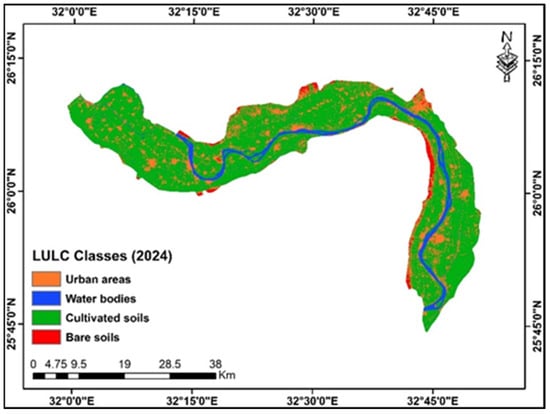
Figure 2.
The classified image of the study area in 2024.
2.2. Data Collection
Three different kinds of data sets were used in the current investigation, as follows:
- (a)
- The Sentinel-5P satellite image data for the four main pollutants—SO2, NO2, O3, and CO products—were obtained annually from the GEE analysis. Since latitude and longitude define the pixels in the Sentinel-5P Level-2 output, the resulting uneven grid made it more challenging to combine several photos. As a result, Level-3 processing was used. This can be resolved by using the harpconvert tool’s bin spatial operation to resample the data to a normal spatial pixel grid (Harpconvert. Available online: http://stcorp.github.io/harp/doc/html/harpconvert.html (accessed on 13 February 2021)). For every variable in a product, the HARP bin_spatial tool projects all time samples into a standard spatial lat/lon grid. As a result, Sentinel-5 provided the CO, NO2, SO2, and O3 photos. After that, cloud-containing images were filtered using cloud filters, followed by spatial and temporal filters, and average maps were extracted using average filters for the years under study (Figure S1). The contaminants listed above were used to calculate the air quality index (AQI) and aggregated air quality index (AAQI). Initial information on the concentration of different contaminants in the atmosphere was derived from datasets acquired by the European Space Agency from the Copernicus Sentinel-5 Precursor satellite project. The high-resolution spectrometer system used by the Sentinel-5 mission uses seven different spectral bands: UV-1 (270–300 nm), UV-2 (300–370 nm), VIS (370–500 nm), NIR-1 (685–710 nm), NIR-2 (745–773 nm), SWIR-1 (1590–1675 nm), and SWIR-3 (2305–2385 nm). The mission operates in the ultraviolet to shortwave infrared range. The MetOp-SG A satellite hosted the device. The yearly average concentrations of SO2, NO2, O3, and CO were calculated using the Google Earth Engine (GEE) to streamline the process of acquiring data from the Copernicus Sentinel-5 Precursor satellite (simplification of data processing of net CDF files). GEE offers a robust and adaptable environment for working with a variety of remote-sensing, satellite, and other geospatial datasets, including Sentinel-5 Precursor data. It consists of a cloud-based computing platform for analyzing and processing large-scale geospatial data. The capacity of GEE to effectively process and analyze vast volumes of data without the need for pricey computer hardware or software is one of its main benefits when used for geospatial analysis. Additionally, GEE provides a collaborative platform for exchanging code, data, and analysis findings. The concentration of pollutants was estimated using the “Sentinel-5P L3” collection (e.g., COPERNICUS/S5P/OFFL/L3_NO2 for nitrogen dioxide). Several filtering techniques (to achieve average annual and monthly values), data processing techniques (such as cropping within the limits of the study area), and additional analyses of the raster values of pollutants were employed for the collection.
- (b)
- The MODIS aerosol optical density (AOD) product’s annual satellite image data were gathered from the GEE platform. The MODIS sensors on NASA’s Aqua and Terra satellites use 36 spectral bands across a broad spectral range (from 410 to 1500 nm) to provide near-global daily readings [69]. In December 1999, MODIS was introduced on the Aqua platform, and in late May 2002, it was introduced on the Terra platform [70]. About 42 satellites with AOD recovery bands have been launched worldwide so far. MODIS AOD products are now among the most widely utilized and well-liked AOD data sources by academics because of their high retrieval accuracy, ease of use, and availability [71]. The Moderate Resolution Imaging Spectroradiometers (MODIS) on the NASA satellites Terra and Aqua provide the most widely used AOD datasets in air quality research. The acquired data demonstrated its applicability for evaluating air quality and providing further information on the spatial distribution of aerosols [72]. To determine the PM2.5 concentration level, an increasing number of studies have employed diverse AOD data as well as alternative models and algorithms in recent years, with positive outcomes [73,74,75]. However, most AOD products used in current studies are mainly based on existing mature AOD products, such as MODIS [73,76]. There are certain drawbacks to using MODIS data to calculate PM, such as the fact that MODIS has a limited lifespan and that its anticipated operating term has already passed [77]. Additionally, efforts are being made to alleviate the constraint of recording both the maximal and minimal PM2.5 peaks. To enhance model performance, more attention should be paid to ground data, atmospheric conditions, and physical features of the regression model [13].
The following formulas were used to calculate PM2.5 and PM10 using the AOD data [78,79]:
- (c)
- Each year, Landsat (OLI/TIRS) sensors, which record temperature data and store them as digital numbers (DNs) within a range from 0 to 255, provide the land surface temperature (LST) [80]. Each image that was used was acquired during the study years. To convert DNs to Kelvin degrees, the following steps are performed:
- (1)
- Transforming DN into spectral radiance: In this study, DNs in each band of the image were transformed into physical measurements of sensor radiance Lλ, as shown in the following Equations (3) and (4):
Lλ = top of atmosphere (TOA) radiance (W·sr−··m−m·nm−1);
ML = radiance multiplicative for band 10;
Qcal = quantized and calibrated standard product pixel values (DN);
AL = radiance add band 10;
Qi = the correction for band 10.
- (2)
- Radiance value conversion to brightness temperature: The following formula was used for the conversion of spectral radiance to at-sensor brightness temperature:
top of atmosphere brightness temperature (°C);
Lλ = top of atmosphere (TOA) radiance (W·sr−1·m−2·nm−1);
K1 and K2 are the constants for Landsat (OLI) band 10;
K1 is = 774. 8853;
K2 is = 1321. 0789.
2.3. AQI Calculations
AQI was found by the following Equation (5), which is recommended by the study in [81]:
where:
Ip—the index of pollutant p;
IHi—the AQI value corresponding to BPHi;
ILo—the AQI value corresponding to BPLo;
BPHi—the threshold that is greater than or equal to Cp;
BPLo—the threshold that is less than or equal to Cp;
Cp—the rounded concentration of pollutant p.
The site’s AQI was determined by the value of the highest sub-indices. Table 2 displays the principal contaminants’ AQI categories and corresponding concentrations, as explained by the following equation [81].

Table 2.
AQI categories and corresponding concentrations for major pollutants.
The following Equation (7) was used to construct the aggregated air quality index (AAQI) [68,82]:
where: AAQI—aggregated air quality index;
AQIi—sub-index for single pollutant i.
is a parameter in the range from 1 to ∞; = 1. In earlier research [68,82,83], ranged between 2 and 3. Accordingly, in this investigation, was set at 2.5, consistent with [82,84]. The flowchart of the approach framework utilized in the current study is shown in Figure 3.
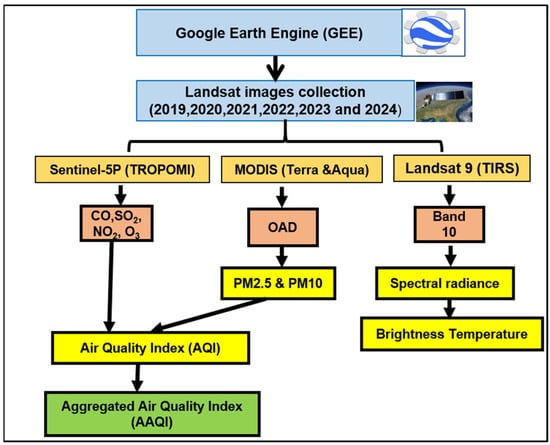
Figure 3.
Flow chart of the methodology followed in the study.
3. Results and Discussion
3.1. Mean Annual LST
LST, gaseous pollutants, and particle matter make up the complex and dynamic composition of urban air pollution, which varies daily and seasonally as a result of human activity, changing land cover, and weather patterns. It is now widely recognized that land cover and urban biophysical and thermal conditions are related [44]. Although both are related to urban land-cover, it is unclear how air pollutants, LST, and, consequently, urban heat islands (UHIs) are related. UHIs are not a sign of air pollution, even if they contribute to its growth. Urbanization has greatly increased human comfort and quality of life, but it has also brought up some unforeseen issues. Among these are urban heat islands (UHI) and urban pollution islands (UPI). Mass car use has only recently led to UPI. It is a result of sprawl or suburban life becoming more commonplace. Over the past century, there have been significant advancements in transportation technologies, leading to the expansion of compact cities into low-density suburbs that rely heavily on cars. The period of widespread motor automobiles can be blamed for many of the air pollution concerns of contemporary cities. With the exception of huge desert towns, UHI is a phenomenon unique to large cities, where the temperature in the urban core is seen to be greater than that of the surrounding rural or natural areas. Because of the effects of climate change, urban heat—dubbed an invisible hazard—has the largest potential for human mortality in several nations [85]. Around the world, heat waves caused 171,856 deaths between 1900 and 2021 [86]. In many cities throughout the world, urban warming is seen as a major health risk [87]. Furthermore, the results in [88] demonstrated the growing interest in UHI–UPI interactions in research, which is indicative of the threats they pose to the ecosystem as well as to human health and life in the modern world. Higher metropolitan temperatures also translate into higher energy consumption, primarily because of the increased need for air conditioning. Pollution levels rise when power plants burn more fossil fuels [89]. Air pollutants raise the LST and are commonly used as markers of air pollution in ambient air. The urban heat island (UHI) effect and air pollution have become pervasive environmental issues in urban areas, and the process of urbanization adds to localized urban climate changes, particularly LST and air quality. Findings of Zhang et al. [90] showed a steady decrease in air pollution and surface urban heat island (SUHI) levels, with a noticeable rise in the intensity of SUHI during the day on summer days. An analysis of interactions showed that SUHI significantly degraded the quality of the air during the day. Furthermore, LST data are frequently used for comparative analyses of urban thermal environments that are linked to residential activities, industrial production, and transportation processes. These activities typically occur in urban areas and release significant amounts of air pollutants into the atmosphere, including CO, SO2, NO2, PM2.5, and PM10 [91].
Anthropogenic and natural sources include, for instance, the combustion of fossil fuels, mediated biomass burning, emissions from industry and traffic, and lightning [92,93]. Additionally, motor vehicle traffic in metropolitan areas emits CO, and lowering traffic speeds may result in an increase in CO emissions. Lower speeds are thought to have the potential to produce large emissions because of things like idling, frequent gear changes, and more stop-and-go traffic, which involves accelerating and decelerating frequently and typically uses a lot of gasoline [94,95]. Particularly in the current study, which is situated in one of the poorest rural areas in Upper Egypt, where nearly 43 percent of the population lived below the poverty line, rural areas in Lower Egypt came in second with 23 percent, and urban areas in Lower Egypt had the lowest percentage of the population living below the poverty line, with nearly 4 percent (https://www.statista.com/statistics/1237070/poverty-rate-national-line-in-egypt-regions/, accessed on 5 March 2025). Therefore, by combining oxygen, CO, and unburned hydrocarbons to form carbon dioxide and water, the catalytic converter helps to reduce the emission of CO [96]. LST and urban carbon emissions (UCE) may have a positive statistical relationship, according to Hong et al. [97]. In another study conducted by Song et al. [98], there was a positive correlation between LST and total carbon emissions of 0.3–0.7. As more and more researchers focus on the effects of carbon emissions and understand the mechanism of reaction between carbon emissions and LST, they discover a positive correlation between the two [99,100]. Oderinde [101] validated that, with the exception of the freshwater swamp forest and the mangrove swamp forest, where an inverse connection was noted, a rise in CO2 emissions resulted in an increase in surface temperature. We found that both LST and CO2 emission rates were higher in areas with less vegetative cover. Because of the high rates of vegetation loss for urbanization and other economic activity, carbon dioxide emissions in these areas have increased. Due to its detrimental effects on several economic sectors, the country is in grave jeopardy as a result of the negative climate changes brought on by the rise in CO2 and LST. These days, it is widely recognized how urban biophysical and thermal conditions relate to land cover. The LST of the analyzed time was generated over the study area in the current study (Figure 4). According to the data, the LST has increased over the past few years and is higher in urban and industrial areas than in other locations (Figure S1). This demonstrates how human activity affected these regions’ LST.
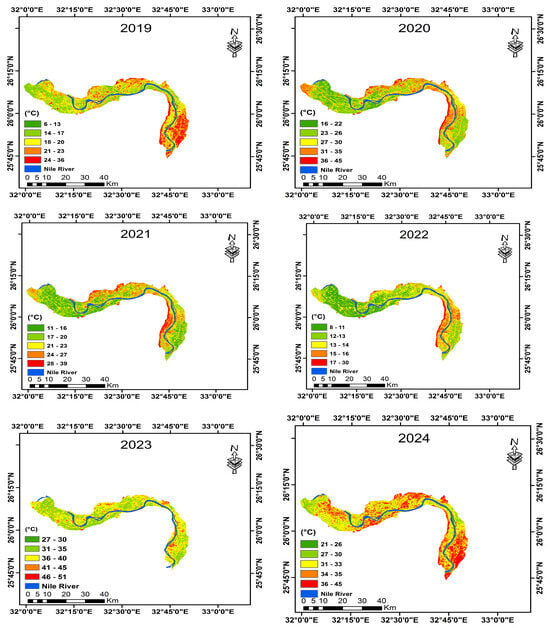
Figure 4.
The distribution of LST in the study area for the period from 2019 to 2024.
Urbanization, industrialization, infrastructure expansion, and an increase in human activity all contribute to the loss of green space, which has an adverse effect on our environment by increasing air pollution and LST [102]. Fuladlu and Altan [44] evaluated the association between LST and the major air pollutants (MAP) in the Iranian province of Tehran using Sentinel imagery. They discovered that the central urban area of the city had the greatest mean concentrations of PM, SO2, and NO2 and that the LST has a positive connection with MAP. Ngarambe et al. [103] evaluated the relationship of urban heat island intensity (UHII) with air pollutants in Seoul city and discovered that NO2, SO2, CO, and PM showed a positive correlation with UHII. There was a noticeable seasonal variation in the relationship between UHII and air pollutants. Prior research has demonstrated that urbanization increases air pollution and LST in a number of urban regions [104,105]. Ulpiani [106] presented a review of the research from the last 30 years on the relationship between LST and air pollution and recommended that, going forward, it would be crucial to examine these parameters jointly rather than individually. Lai and Cheng [107] found that, in the Taiwan Strait, China, surface urban heat island (SUHI) had a negative correlation with O3 and a positive correlation with key pollutants, such as PM, NO2, SO2, and CO. Mishra and Mathew [108], using MODIS images, calculated the urban pollution island intensity (UPII) over Delhi city from the aerosol optical depth (AOD) image and compared it with the SUHI intensity (SUHII). There was no discernible relationship between the two; rather, the change in land cover had a greater impact on the variation of LST. Hereher et al. [2] determined a stronger association of SUHII with CO and NO2; although, it showed weak correlation with SO2 over Greater Cairo, Egypt. It has been established that a wide range of factors affect both LST and air pollutants, including land use/cover, population, elevation, weather, and economic development [109]. Geographical locations have a considerable impact on the association between LST and air pollution, and the existing research is insufficient to fully explain how LST and other air pollutants are related. A city’s air pollution concentration is also influenced by the amount of vegetation and built-up area. It is also crucial to investigate the relationship between air contaminants and land cover indices. Few studies have examined the association between LST and air pollutants at specific sites, but there is a dearth of research on the relationship between air pollutants and land cover features; thus, it needs more investigation. High temperatures, low relative humidity, low wind speeds, and cloudlessness are synoptic circumstances that favor the formation of UHI and severe pollution episodes simultaneously [107]. Particularly at night, urban breezes with low-level inversion and low-level convergence exacerbate local hyperthermia and air [106]. Elevated temperatures speed up some cycles of atmospheric chemistry, producing more ground-level (tropospheric) ozone, more biogenic hydrocarbons (BVOCs), and more synthetic VOCs evaporating from car engines [110]. In regions with extreme heat, air conditioners run for longer hours both during the day and throughout the year. This causes regional power plants to emit more CO2 and ozone precursors [111] and contributes to the amplification of UHI in ever-increasing spirals by releasing exhaust heat into the urban air. Additionally, peak power absorptions aided by UHI (such as during heat waves) require more generation capacity, which is usually provided by less sustainable power plants. Accordingly, UHIs not only help to create a dust dome above the cityscape but also help to maintain themself by combining a recurrent pattern that intensifies and prolongs pollution episodes. Conversely, warmer air encourages turbulent mixing, which facilitates the dispersal of primary pollutants to higher atmospheric layers (Sarrat [112]).
3.2. Mean Annual Pollutants Concentrations
The mean annual concentrations of each studied air pollutants are analyzed and presented hereunder:
3.2.1. AQI for Particulate Matter (PM2.5 and PM10)
The complex mixture of particles known as particulate matter (PM) can be solid, liquid, or both. They differ in size, composition, and place of origin. Region, season, day, weather, and other variables all affect the precise makeup and size distribution of PM [113]. Total suspended particulates (TSP), PM10 (particles with a diameter less than 10 μm, seen near roads and dusty industries), PM2.5 (particles with a diameter less than 2.5 μm, seen in smoke and haze), and ultrafine particulates (UFPs) (particles with a diameter less than 0.1 μm, or PM0.1) are the four categories into which PM can be separated [113]. The AOD-PM2.5/PM10 empirical–statistical models generated by [78,79] were used in the current investigation to estimate the concentrations of PM2.5 and PM10. The yearly average PM2.5 AQI ranged from a low of 283 to a maximum of 517 between 2019 and 2024 (Figure 5). Based on this, the area is classified as very unhealthy to hazardous (Table 3). In contrast, the PM10 AQI ranged from 422 to 794, indicating the risks associated with this pollutant (Figure 6). The primary sources of PM include burning solid waste and agricultural waste, dust and sand storms, and emissions from vehicles and industries [114]. Three sugar factories, one spinning and weaving mill, and the Aluminium Complex—one of the largest industrial facilities in the Middle East—are all located inside the governorate. Two industrial zones are also located inside the governorate; the first is located at Qaft Markaz, a group of villages in Kalaheen. The nonwoven fabric plant, the antibiotic factory, the food projects, and the plastics industries are also among the most significant undertakings. Investors are encouraged to launch their projects in the second industrial zone, Yahaw in Naggâ Hamady, which has the necessary infrastructure.
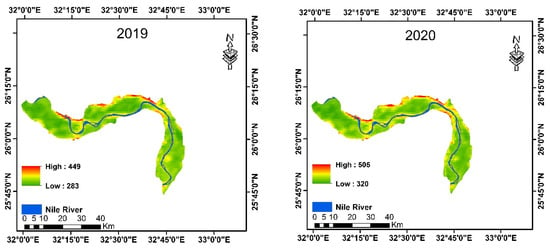
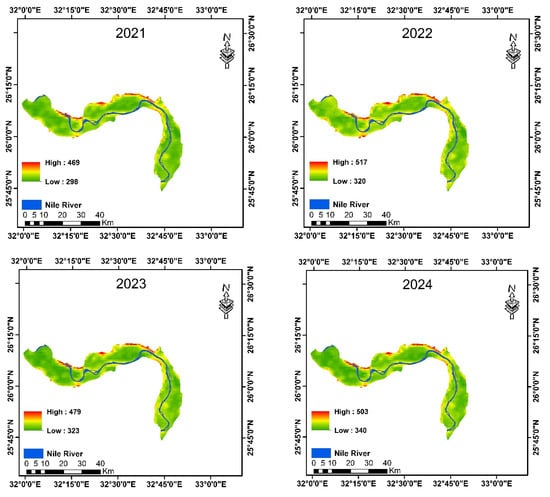
Figure 5.
The distribution of the AQI of PM2.5 in the study area for the period from 2019 to 2024.

Table 3.
The minimum and maximum annual AQI of major air pollutants over the study area.


Figure 6.
The distribution of the AQI of PM10 in the study area for the period from 2019 to 2024.
3.2.2. AQI for Carbon Monoxide (CO)
In addition to traffic emissions, industrial output, and biomass burning, the incomplete combustion of substances including petrol, natural gas, oil, coal, and wood can contribute to the problem of CO emissions into the atmosphere [115]. The annual AQI for CO ranged from 286 to 983 ppm over the study period. The AQI increased sharply between 2019 and 2020 but then continued to rise progressively from 2020 to 2024 (Figure 7 and Table 2). Locality and population density are typically associated with high CO concentrations [116]. Furthermore, anthropogenic activities, car emissions, and the locations of numerous power plants and enterprises may all contribute to the high CO concentration [117]. The WHO states that the CO AQI might be classified as having very unhealthy or hazardous effects [118].

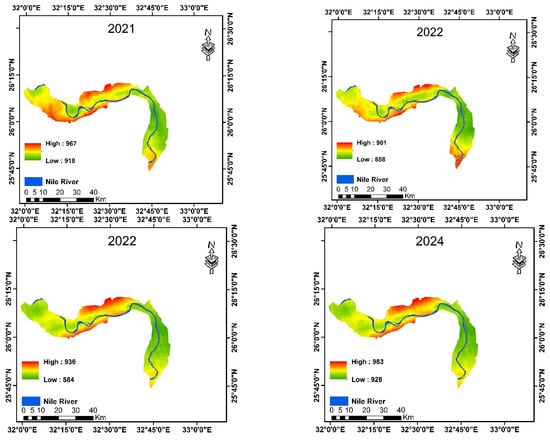
Figure 7.
The distribution of the AQI of CO in the study area for the period from 2019 to 2024.
3.2.3. AQI for Nitrogen Dioxide (NO2)
A major health danger in urban and industrial regions, NO2 is a hazardous air pollutant that causes severe health effects and premature death. It is the cause of tens of deaths in Cairo each year. Figure 8 shows that the AQI for NO2 fluctuated between unhealthy for sensitive populations and unhealthy, with values ranging from 135 to 165. Fuel combustion is the main source of NO2 in the atmosphere. Emissions from power plants, automobiles, trucks, buses, and off-road machinery produce NO2 (https://www.epa.gov/no2-pollution/basic-information-about-no2, accessed on 7 March 2025); this finding is consistent with the findings of Hereher et al. [2], which explains why it is more prevalent in places with a high population density. Numerous emission sources, including natural and vehicle emissions, are connected to the amount of NO2 in the atmosphere.
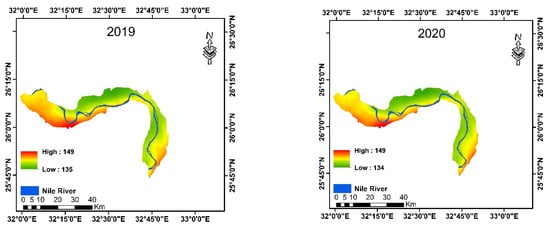
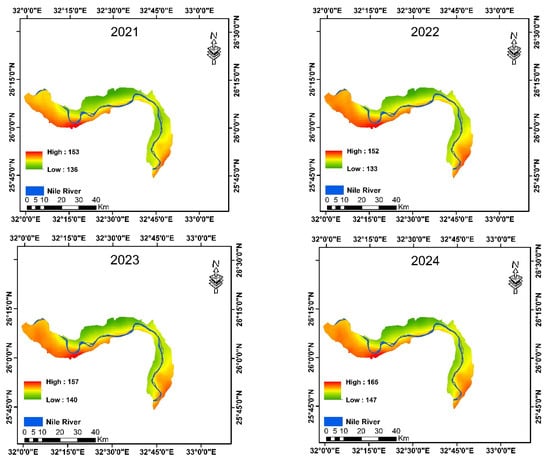
Figure 8.
The distribution of the AQI of NO2 in the study area for the period from 2019 to 2024.
3.2.4. AQI for Sulfur Dioxide (SO2)
Concentrations of SO2 gas in the troposphere of the research area are mostly linked to population density and industrial and power generation facilities. This trend is especially evident in areas with sizable textile, smelting, chemical, petroleum, and power generation facilities. Since high sulfur heavy fuel is mostly used in these industrial processes, SO2 emissions are produced, making the area a major hotspot for SO2 emissions [26]. Even while the majority of the SO2 concentration in the study area is caused by emissions from particular industrial activities, it is interesting to see that some residential areas also have relatively high SO2 levels. The significant use of diesel-powered trucks for building new asphalt roads and performing construction tasks is the main cause of these abnormally high SO2 concentrations in the new urban neighborhoods [26]. As seen in Figure 9, the AQI categories varied from good to hazardous, with the annual average of the AQI for SO2 over the examined period ranging from 29 to 339.

Figure 9.
The distribution of the AQI of SO2 in the study area for the period from 2019 to 2024.
3.2.5. AQI for Ozone (O3)
Tropospheric ozone is a dangerous air contaminant and a greenhouse gas. Unlike other gases and particles released into the atmosphere, ozone is produced when sunlight interacts with a variety of other air contaminants. Methane, a strong greenhouse gas, as well as nitrogen oxides, non-methane volatile organic compounds, and carbon monoxide—all dangerous air pollutants—are the primary causes of the high concentrations of this poisonous gas. These “precursors” come from a variety of sources, such as industry, transportation, energy production, livestock, and wildfires. People and the earth are harmed by high tropospheric ozone levels. The greenhouse effect, which contributes to both global warming and regional climatic consequences, is driven by tropospheric ozone. Inhaling it at ground level causes respiratory and other health problems. It interferes with the growth of staple crops like maize and wheat when it is spread throughout farms. On the other hand, the stratosphere contains the greatest concentration of ozone molecules, with over 90% of them located between 15 and 30 km above the ground. Life on Earth is protected by stratospheric ozone, which blocks off a significant portion of the sun’s ultraviolet (UV) radiation. Increased UV-B radiation (280–320 nm) can impair photosynthesis, lead to skin cancer, and impair immunity [119].
Two main pollutants—NOx (NO and NO2) and hydrocarbons from industry, traffic, vegetation, and biomass burning—photochemically react to produce ozone [120,121,122,123,124,125]. During the night, NO is released by nearby sources, and ground deposition destroys the ozone. Due to photochemical production from anthropogenic emissions throughout the day, urban ozone diurnal fluctuation is often characterized by higher concentrations during the day and lower concentrations at night. It has also been acknowledged that “next-day” surface ozone variations may be influenced by ozone stored in nighttime residual layers (RL) [126]. Because they influence boundary layer stability, carry pollutants at the regional level, and have the potential to alter urban air quality, nocturnal low-level jets (NLLJs) are a significant phenomenon at night [127]. The ozone doses in Qena were unexpectedly stable (Table 2 and Figure 10) during the analyzed time, as evidenced by the Ozone’s AQI that varied between 304 and 349, but in 2021 and 2022, it remained steady, with very minor variations in 2019, 2020, 2023, and 2024. The O3 concentrations in the research region fell into the very unhealthy (201–300) to hazardous category (301–500) according to the EPA [81] standards. This could indicate that, during the brief period of heavy photochemical smog, there are more health risks and crop damage in and around greater Qena. Ozone does not reach exceptionally high concentrations in the ambient urban air of Qena as may be expected, despite the city’s high main pollutant emission rates and heavy sun irradiation.
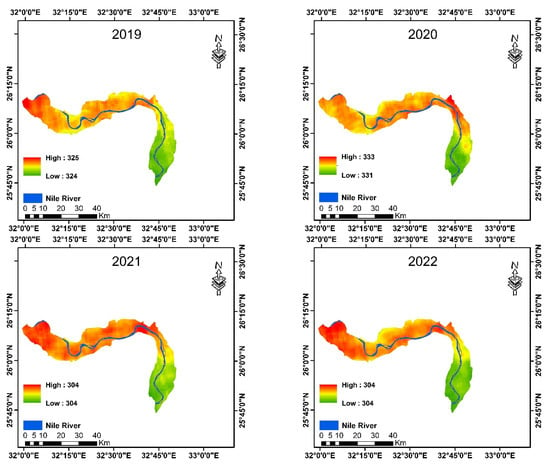
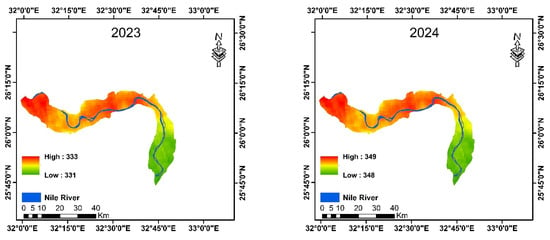
Figure 10.
The distribution of the AQI of O3 in the study area for the period from 2019 to 2024.
3.3. Aggregated Air Quality Index (AAQI)
Based on how they are calculated, AQIs can be divided into two categories. The first type computes the sub-indices for all pollutants and then uses the highest sub-index as the AQI based on local air pollution regulations or USEPA requirements. With this kind of AQI, a lot of information is eliminated while public awareness is raised [66]. The second kind of AQI combines several air contaminants in an effort to measure their combined effects. The AAQI is a more comprehensive indicator of air quality and is more practical for environmental management because it includes a wide range of air quality contaminants [84]. If more than one pollutant is above the critical concentration, it might be more effective than the USEPA-AQI. According to the findings of epidemiological studies on the impact of each pollutant on human health, the Environmental Protection Agency (EPA) [81] established breakpoint concentrations. Each pollutant receives a value on a scale from 0 to 500 following the standardizing procedure (i.e., 0–50 (good), 51–100 (moderate), 101–150 (unhealthy for sensitive groups), 151–200 (unhealthy), 201–300 (very unhealthy), 301–400 (hazardous), and 401–500 (hazardous)). According to the CAA (Clean Air Act), the alert level for human health on any particular day is a value more than 100. The AAQI varied from very unhealthy to hazardous in the current investigation, with a range of 265–489 from 2019 to 2024 (Table 4 and Figure 11). Table 4 and Figure 11 clearly show that the measured pollutants were above the EPA [81] limits; therefore, it might make sense to utilize the AAQI. However, even if some of the pollutants had good levels, it might not be acceptable for them to contribute to the air quality index’s rise. Many air pollutants associated with industrial production, residential activities, and transport processes are usually located in urban areas that emit large amounts of air pollutants, such as fine particulate matter (PM2.5, particulate matter < 2.5 µm), coarse particulate matter (PM10), SO2, NO2, and CO into the atmosphere. Consequently, there is a significant relationship between AAQI and air pollutants.

Table 4.
AAQI values in the studied area.
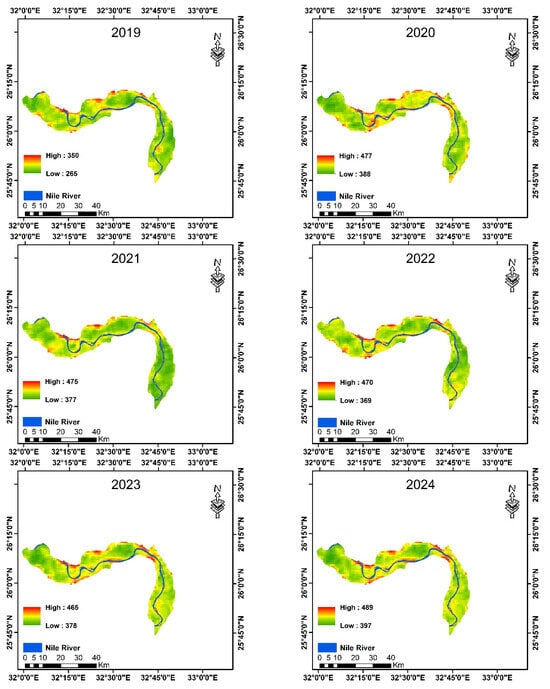
Figure 11.
The distribution of the AAQI in the study area for the period from 2019 to 2024.
Given the abundance of industries in the research area, including those producing pepper, sugar, gas, and aluminum, industrial activity may be the reason for the noticeable rise in the AAQI (Figure 12 and Figure 13). Furthermore, it is anticipated that these measures have a major impact on the quantity of air pollutants from vehicles and industries given the closure of industries and limitations on community activities, such as intercity transportation and urban traffic sites, because of vehicle emissions [128]. Fossil fuel combustion produces nitrogen oxides, which are a reliable indicator of air pollution from vehicles. It has been demonstrated that transportation accounts for over 50% and 23% of the total nitrogen oxides (NOx) in both industrialized and developing nations [129]. Tropospheric ozone, which is a major health risk because it can cause inflammation and increase airway hyperreactivity, is created when this pollutant combines with volatile organic chemicals and the sun’s UV rays [130].
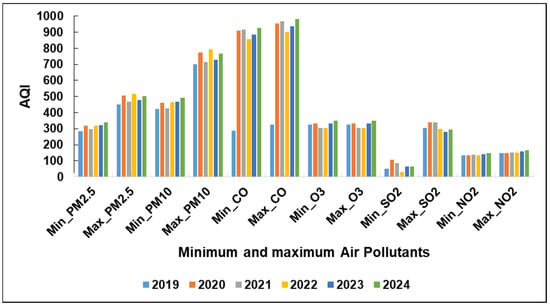
Figure 12.
Minimum and maximum air pollutants over the study area during the studied period from 2019 to 2024.
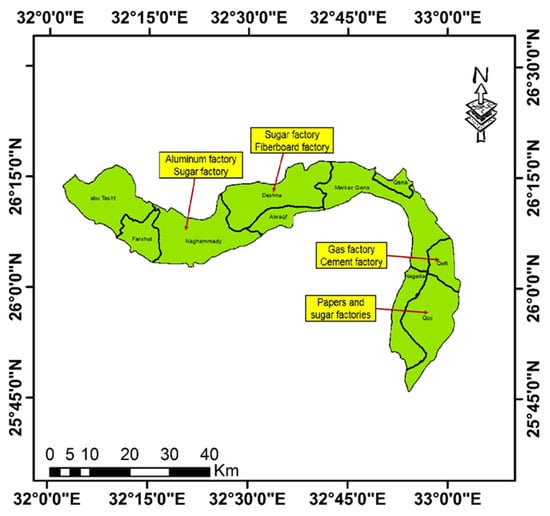
Figure 13.
Cities and factories located in the study area.
4. Limitations and Uncertainties of the Current Study
Since remotely sensed data offer worldwide coverage with acceptable spatial resolution, they can be used to supplement data from chemical transport models and ground measurements from air quality stations. This allows for the monitoring of areas where no observations are available [131,132]. However, there are certain drawbacks to remotely sensed data. While monitoring stations offer hourly data, the temporal resolution is lower than ground measurements, with the best resolution possible being daily for measurements across the entire globe. Additional limitations include the fact that remote sensing does not directly measure pollutant concentrations because it measures the integrated concentration of the pollutant from ground level to the top of the atmosphere, which must be converted using ground data to determine actual ground concentrations [131,133]. Data may also not be available for all satellite passages due to the significant impact of clouds on the quality of satellite retrievals [14]. In order to improve outcomes, machine learning techniques like neural networks and the random forest model are suggested for further study. Weather, land cover, and temporal data should also be integrated [134].
5. Conclusions
One of the main environmental stressors that has detrimental effects on ecosystem balance and human health is air pollution. To provide relevant data regarding air quality across wide areas, remote sensing imagery has recently been used as a more economical and time-efficient alternative to traditional monitoring approaches. This study is considered an investigation since it is the first attempt to evaluate the air quality index using GEE and aggregated air quality index for tracking and charting the spatiotemporal air quality in the studied area. In this context, the Sentinel-5P satellite provided high-resolution images of atmospheric pollutants including NO2, O3, CO, and SO2. Additionally, both PM2.5 and PM10 were calculated using MODIS data. Lastly, Landsat (OLI/TIRS) was used to retrieve the LST. LST data are frequently used to compare urban thermal environments that are linked to residential activities, industrial production, and transportation processes. These activities typically occur in urban areas and release significant amounts of air pollutants into the atmosphere, including CO, SO2, NO2, PM2.5, particulate matter < 2.5 µm, and PM10. Because industry, urbanization, and traffic are the main sources of air pollution in the research region, the data obtained demonstrated significant variance in the concentrations of all pollutants under study, except NO2, SO2, CO, and O3, which had steady concentrations in 2021 and 2022 and only minor variations in 2019 2020 2023, and 2024. Additionally, the findings showed that transportation and industry are the main causes of the high air pollution emissions in the studied area. Furthermore, frequent problems with air pollution are brought on by the unchecked urban growth of the urban centers. The findings demonstrated how well satellites detected air contaminants in the study area because of their nearly constant worldwide coverage. Furthermore, the superior geographical dispersion of the aerosols provided by the satellite data is thought to be challenging to measure from ground measurements, particularly during storm occurrences. Additionally, there are not enough ground measurements because a comprehensive ground monitoring network is not practical for evaluating and tracking surface air quality. Ad hoc monitoring stations are placed in regions that are subjectively thought to be of interest to land use and population or in traffic hot spots. Ad hoc monitoring station placement, however, could result in poorly informed choices for long-term exposure studies. Therefore, regional patterns can benefit from the interpolation of pollution data gathered by regulatory air quality monitoring stations; yet, city-level data collection is made difficult by the sparse arrangement of air quality monitoring networks. By using models that assist in accounting for the fluctuation of air pollution and land use characteristics within cities, the locations of these sites could be improved. Satellite data can be used as a stand-in to measure the surface level of air quality, even though measurements of air contaminants using this data have some degree of inaccuracy. Understanding the uncertainties related to satellite data is so essential. We strongly advise users to focus on the density of data for a particular region and the quality flags. This is a crucial topic that health authorities can utilize to preserve human health and enhance environmental sustainability.
Supplementary Materials
The following supporting information can be downloaded at: https://www.mdpi.com/article/10.3390/su17083450/s1, Figure S1: some codes which used by GEE in current study.
Author Contributions
Conceptualization, A.-r.A.M., M.S.S., E.A.A. and J.E.M.d.L.; Methodology, A.-r.A.M., M.S.S., E.A.A. and J.E.M.d.L.; Software, A.-r.A.M., M.S.S., E.A.A. and J.E.M.d.L.; Validation, A.-r.A.M., M.S.S., E.A.A. and J.E.M.d.L.; Formal analysis, A.-r.A.M., M.S.S., E.A.A. and J.E.M.d.L.; Investigation, A.-r.A.M., M.S.S., E.A.A. and J.E.M.d.L.; Resources, A.-r.A.M., M.S.S., E.A.A. and J.E.M.d.L.; Data curation, A.-r.A.M., M.S.S., E.A.A. and J.E.M.d.L.; Writing—original draft, A.-r.A.M., M.S.S., T.A., E.A.A., A.S.E.-S. and J.E.M.d.L.; Writing—review & editing, A.-r.A.M., M.S.S., E.A.A. and J.E.M.d.L.; Visualization, A.-r.A.M., M.S.S. and E.A.A.; Supervision, A.-r.A.M., M.S.S., T.A. and A.S.E.-S.; Project administration, M.S.S., T.A. and A.S.E.-S.; Funding acquisition, T.A., A.S.E.-S. and J.E.M.d.L. All authors have read and agreed to the published version of the manuscript.
Funding
Researchers Supporting Project number (RSPD2025R791), King Saud University, Riyadh, Saudi Arabia.
Institutional Review Board Statement
Not applicable.
Informed Consent Statement
Not applicable.
Data Availability Statement
Data are contained within the article and Supplementary Files.
Acknowledgments
The authors extend their appreciation to Researchers Supporting Project number (RSPD2025R791), King Saud University, Riyadh, Saudi Arabia. The authors extend their appreciation to University of Cordoba, “Incentives for groups under the Enrique Aguilar Benítez de Lugo research plan 2024” for partiality supporting this work.
Conflicts of Interest
The authors declare no conflicts of interest.
References
- Dong, D.; Wang, J. Air pollution as a substantial threat to the improvement of agricultural total factor productivity: Global evidence. Envir Inter. 2023, 173, 107842. [Google Scholar] [CrossRef]
- Hereher, M.; Eissa, R.; Alqasemi, A.; El Kenawy, A.M. Assessment of air pollution at Greater Cairo in relation to the spatial variability of surface urban heat island. Environ. Sci. Pollut. Res. 2022, 29, 21412–21425. [Google Scholar] [CrossRef] [PubMed]
- Wen, H.-X.; Nie, P.-Y.; Liu, M.; Peng, R.; Guo, T.; Wang, C.; Xie, X.-B. Multi-health effects of clean residential heating: Evidences from rural China’s coal-to-gas/electricity project. Energy Sustain. Dev. 2023, 73, 66–75. [Google Scholar] [CrossRef]
- Mostafa, M.K.; Gamal, G.; Wafiq, A. The impact of COVID 19 on air pollution levels and other environmental indicators-A case study of Egypt. J. Environ. Manag. 2021, 277, 111496. [Google Scholar] [CrossRef]
- Intergovernmental Panel on Climate Change (IPCC). C.o.W.G.I., II and III to the Sixth Assessment Report of the Intergovernmental Panel on Climate Change. Available online: https://www.ipcc.ch/report/ar6/wg1/ (accessed on 1 January 2025).
- Liu, Q.; Yang, D.; Cao, L. Evolution and Prediction of the Coupling Coordination Degree of Production–Living–Ecological Space Based on Land Use Dynamics in the Daqing River Basin, China. Sustainability 2022, 14, 10864. [Google Scholar] [CrossRef]
- Nouri, F.; Taheri, M.; Ziaddini, M.; Najafian, J.; Rabiei, K.; Pourmoghadas, A.; Shariful Islam, S.M.; Sarrafzadegan, N. Effects of sulfur dioxide and particulate matter pollution on hospital admissions for hypertensive cardiovascular disease: A time series analysis. Front. Physiol. 2023, 14, 1124967. [Google Scholar] [CrossRef] [PubMed] [PubMed Central]
- Hwang, J.; Maharjan, K.; Cho, H. A review of hydrogen utilization in power generation and transportation sectors: Achievements and future challenges. Int. J. Hydrogen Energy. 2023, 48, 28629–28648. [Google Scholar] [CrossRef]
- Morillas, C.; Alvarez, S.; Serio, C.; Masiello, G.; Martinez, S. TROPOMI NO2 Sentinel-5P data in the Community of Madrid: A detailed consistency analysis with in situ surface observations. Remote Sens. Appl. Soc. Environ. 2024, 33, 101083. [Google Scholar] [CrossRef]
- Nyaga, E.W. Aerosol Remote Sensing and Modelling: Estimation of Vehicular Emission Impact on Air Pollution in Nairobi, Kenya; University of Nairobi: Nairobi, Kenya, 2021. [Google Scholar]
- Gorelick, N.; Hancher, M.; Dixon, M.; Ilyushchenko, S.; Thau, D.; Moore, R. Google Earth Engine: Planetary-scale geospatial analysis for everyone. Remote Sens. Environ. 2017, 202, 18–27. [Google Scholar] [CrossRef]
- Pérez-Cutillas, P.; Pérez-Navarro, A.; Conesa-García, C.; Zema, D.A.; Amado-Álvarez, J.P. What is going on within google earth engine? A systematic review and meta-analysis. Remote Sens. Appl. Soc. Environ. 2023, 29, 100907. [Google Scholar] [CrossRef]
- Nguyen, T.T.; Bui, H.Q.; Pham, H.V.; Luu, H.V.; Man, C.D.; Pham, H.N.; Le, H.T.; Nguyen, T.T. Particulate matter concentration mapping from MODIS satellite data: A Vietnamese case study. Environ. Res. Lett. 2015, 10, 095016. [Google Scholar] [CrossRef]
- Xiong, J.; Thenkabail, P.S.; Gumma, M.K.; Teluguntla, P.; Poehnelt, J.; Congalton, R.G.; Yadav, K.; Thau, D. Automated cropland mapping of continental Africa using Google Earth Engine cloud computing. J. Photogramm. Remote Sens. 2017, 126, 225–244. [Google Scholar] [CrossRef]
- Oliphant, A.J.; Thenkabail, P.S.; Teluguntla, P.; Xiong, J.; Gumma, M.K.; Congalton, R.G.; Yadav, K. Mapping cropland extent of Southeast and Northeast Asia using multi-year time-series Landsat 30-m data using a random forest classifier on the Google Earth Engine Cloud. Int. J. Appl. Earth Obs. Geoinf. 2019, 81, 110–124. [Google Scholar] [CrossRef]
- Xie, S.; Liu, L.; Zhang, X.; Yang, J.; Chen, X.; Gao, Y. Automatic land-cover mapping using landsat time-series data based on google earth engine. Remote Sens. 2019, 11, 3023. [Google Scholar] [CrossRef]
- Gumma, M.K.; Thenkabail, P.S.; Teluguntla, P.G.; Oliphant, A.; Xiong, J.; Giri, C.; Pyla, V.; Dixit, S.; Whitbread, A.M. Agricultural cropland extent and areas of South Asia derived using Landsat satellite 30-m time-series big-data using random forest machine learning algorithms on the Google Earth Engine cloud. GIScience Remote Sens. 2020, 57, 302–322. [Google Scholar] [CrossRef]
- Zurqani, H.A.; Post, C.J.; Mikhailova, E.A.; Schlautman, M.A.; Sharp, J.L. Geospatial analysis of land use change in the Savannah River Basin using Google Earth Engine. Int. J. Appl. Earth Obs. Geoinf. 2018, 69, 175–185. [Google Scholar] [CrossRef]
- Ghorbanian, A.; Kakooei, M.; Amani, M.; Mahdavi, S.; Mohammadzadeh, A.; Hasanlou, M. Improved land cover map of Iran using Sentinel imagery within Google Earth Engine and a novel automatic workflow for land cover classification using migrated training samples. J. Photogramm. Remote Sens. 2020, 167, 276–288. [Google Scholar] [CrossRef]
- Abdelsamie, E.A.; Mustafa, A.-r.A.; El-Sorogy, A.S.; Maswada, H.F.; Almadani, S.A.; Shokr, M.S.; El-Desoky, A.I.; Meroño de Larriva, J.E. Current and Potential Land Use/Land Cover (LULC) Scenarios in Dry Lands Using a CA-Markov Simulation Model and the Classification and Regression Tree (CART) Method: A Cloud-Based Google Earth Engine (GEE) Approach. Sustainability 2024, 16, 11130. [Google Scholar] [CrossRef]
- Amani, M.; Brisco, B.; Afshar, M.; Mirmazloumi, S.M.; Mahdavi, S.; Mirzadeh, S.M.J.; Huang, W.; Granger, J. A generalized supervised classification scheme to produce provincial wetland inventory maps: An application of Google Earth Engine for big geo data processing. Big Earth Data 2019, 3, 378–394. [Google Scholar] [CrossRef]
- Mahdianpari, M.; Jafarzadeh, H.; Granger, J.E.; Mohammadimanesh, F.; Brisco, B.; Salehi, B.; Homayouni, S.; Weng, Q. A large-scale change monitoring of wetlands using time series Landsat imagery on Google Earth Engine: A case study in Newfoundland. GIScience Remote Sens. 2020, 57, 1102–1124. [Google Scholar] [CrossRef]
- El-Hamid, H.T.A.; Nour-Eldin, H.; Rebouh, N.Y.; El-Zeiny, A.M. Past and future changes of land use/land cover and the potential impact on ecosystem services value of Damietta Governorate, Egypt. Land 2022, 11, 2169. [Google Scholar] [CrossRef]
- Meng, Q.; Richmond-Bryant, J.; Lu, S.-E.; Buckley, B.; Welsh, W.J.; Whitsel, E.A.; Hanna, A.; Yeatts, K.B.; Warren, J.; Herring, A.H. Cardiovascular outcomes and the physical and chemical properties of metal ions found in particulate matter air pollution: A QICAR study. Environ. Health Perspect. 2013, 121, 558–564. [Google Scholar] [CrossRef]
- Ghasempour, F.; Sekertekin, A.; Kutoglu, S.H. Google Earth Engine based spatio-temporal analysis of air pollutants before and during the first wave COVID-19 outbreak over Turkey via remote sensing. J. Clean. Prod. 2021, 319, 128599. [Google Scholar] [CrossRef] [PubMed]
- Sameh, S.; Zarzoura, F.; El-Mewafi, M. Spatio-temporal Analysis Mapping of Air Quality Monitoring in Cairo using Sentinel-5 satellite data and Google earth engine. Mansoura Eng. J. 2023, 49, 3. [Google Scholar] [CrossRef]
- Halder, B.; Ahmadianfar, I.; Heddam, S.; Mussa, Z.H.; Goliatt, L.; Tan, M.L.; Sa’adi, Z.; Al-Khafaji, Z.; Al-Ansari, N.; Jawad, A.H. Machine learning-based country-level annual air pollutants exploration using Sentinel-5P and Google Earth Engine. Sci. Rep. 2023, 13, 7968. [Google Scholar] [CrossRef]
- Aldabash, M.; Bektas Balcik, F.; Glantz, P. Validation of MODIS C6. 1 and MERRA-2 AOD using AERONET observations: A comparative study over Turkey. Atmosphere 2020, 11, 905. [Google Scholar] [CrossRef]
- Kaplan, G.; Avdan, Z.Y. Space-borne air pollution observation from sentinel-5p tropomi: Relationship between pollutants, geographical and demographic data. J. Eng. Geol. 2020, 5, 130–137. [Google Scholar] [CrossRef]
- de Laat, A.; Vazquez-Navarro, M.; Theys, N.; Stammes, P. Analysis of properties of the 19 February 2018 volcanic eruption of Mount Sinabung in S5P/TROPOMI and Himawari-8 satellite data. Nat. Hazards Earth Syst. Sci. 2020, 20, 1203–1217. [Google Scholar] [CrossRef]
- Chang, R.; Zhao, J.; Li, W.; Jia, J. Temporal and spatial distribution of SO2 in the process of haze in north China based on remote sensing data. Int. J. Environ. Monit. Anal. 2019, 7, 27. [Google Scholar]
- Salmabadi, H.; Saeedi, M. Monitoring of SO2 column concentration over Iran using satellite-based observations during 2005-2016. Pollution 2019, 5, 257–268. [Google Scholar]
- Wang, G.; Deng, X.-J.; Wang, C.-L.; Zhang, X.-Y.; Yan, H.-H.; Chen, D.-H.; Guo, T. A new and detailed assessment of the spatiotemporal characteristics of the SO2 distribution in the pearl river delta region of China and the effect of SO2 emission reduction. Aerosol Air Qual. Res. 2019, 19, 1900–1910. [Google Scholar] [CrossRef]
- Feng, Y.; Chen, D.; Zhang, X. Atmospheric aerosol pollution across China: A spatiotemporal analysis of satellite-based aerosol optical depth during 2000–2016. Int. J. Digit. Earth 2019, 12, 843–857. [Google Scholar] [CrossRef]
- Hajiloo, F.; Hamzeh, S.; Gheysari, M. Impact assessment of meteorological and environmental parameters on PM 2.5 concentrations using remote sensing data and GWR analysis (case study of Tehran). Environ. Sci. Pollut. Res. 2019, 26, 24331–24345. [Google Scholar] [CrossRef]
- Borsdorff, T.; aan de Brugh, J.; Pandey, S.; Hasekamp, O.; Aben, I.; Houweling, S.; Landgraf, J. Carbon monoxide air pollution on sub-city scales and along arterial roads detected by the Tropospheric Monitoring Instrument. Atmos. Chem. Phys. 2019, 19, 3579–3588. [Google Scholar] [CrossRef]
- O’Brien, D.; Polonsky, I.; Utembe, S.; Rayner, P. Remote sensing CO2, CH4 and CO emissions in a polluted urban environment. Atmos. Meas. Tech. Discuss. 2016, 9, 4633–4654. [Google Scholar] [CrossRef]
- Tzortziou, M.; Parker, O.; Lamb, B.; Herman, J.R.; Lamsal, L.; Stauffer, R.; Abuhassan, N. Atmospheric Trace Gas (NO2 and O3) variability in South Korean coastal waters, and implications for remote sensing of coastal ocean color dynamics. Remote Sens. 2018, 10, 1587. [Google Scholar] [CrossRef]
- Xu, J.; Heue, K.-P.; Coldewey-Egbers, M.; Romahn, F.; Doicu, A.; Loyola, D. Full-Physics Inverse Learning Machine for satellite remote sensing of ozone profile shapes and tropospheric columns. Int. Arch. Photogramm. Remote Sens. 2018, 42, 1995–1998. [Google Scholar] [CrossRef]
- Borsdorff, T.; Aan de Brugh, J.; Hu, H.; Aben, I.; Hasekamp, O.; Landgraf, J. Measuring carbon monoxide with TROPOMI: First results and a comparison with ECMWF-IFS analysis data. Geophys. Res. Lett. 2018, 45, 2826–2832. [Google Scholar] [CrossRef]
- Garane, K.; Koukouli, M.-E.; Verhoelst, T.; Lerot, C.; Heue, K.-P.; Fioletov, V.; Balis, D.; Bais, A.; Bazureau, A.; Dehn, A. TROPOMI/S5P total ozone column data: Global ground-based validation and consistency with other satellite missions. Atmos. Meas. Tech. 2019, 12, 5263–5287. [Google Scholar] [CrossRef]
- Al-Alola, S.S.; Alkadi, I.I.; Alogayell, H.M.; Mohamed, S.A.; Ismail, I.Y. Air quality estimation using remote sensing and GIS-spatial technologies along Al-Shamal train pathway, Al-Qurayyat City in Saudi Arabia. Environ. Sustain. Indic. 2022, 15, 100184. [Google Scholar] [CrossRef]
- Leguijt, G.; Maasakkers, J.D.; Denier van der Gon, H.A.; Segers, A.J.; Borsdorff, T.; Aben, I. Quantification of carbon monoxide emissions from African cities using TROPOMI. Geosci. Model Dev. 2023, 2023, 8899–8919. [Google Scholar] [CrossRef]
- Fuladlu, K.; Altan, H. Examining land surface temperature and relations with the major air pollutants: A remote sensing research in case of Tehran. Urban Clim. 2021, 39, 100958. [Google Scholar] [CrossRef]
- Nations, U. World Urbanization Prospects: The 2014 Revision, Highlights; Department of Economic and Social Affairs, Population Division, United Nations: New York, NY, USA, 2014; Volume 32. [Google Scholar]
- World Urbanization Prospects: The 2018 Revision 2018; United Nation: NewYork, NY, USA. 2019. Available online: https://esa.un.org/unpd/wup/ (accessed on 1 January 2025).
- Fuladlu, K. Urban sprawl negative impact: Enkomi return phase. J. Contemp. Urban Aff. 2019, 3, 44–51. [Google Scholar] [CrossRef]
- Fuladlu, K. Urban sprawl measurement with use of VMT pattern: A longitudinal method in case of Famagusta. Int. J. Adv. Appl. Sci. 2020, 7, 12–19. [Google Scholar] [CrossRef]
- Fuladlu, K.; Riza, M.; İlkan, M. Impact of urban sprawl: The case of the Famagusta, Cyprus. In Proceedings of the 1st Regional Conference: Cyprus Network of Urban Morphology CyNUM, Eastern Mediterranean University, Famagusta, Northern Cyprus, 16–18 May 2018; pp. 16–18. [Google Scholar]
- El Kamouri, H.E.A.; Essamoud, R.; Hakdaoui, M. Remote Sensing and Geospatial Approach for Assessing the Impact of Automobiles on Air Quality, Case Study: Casablanca. J. Geosci. Environ. Prot. 2024, 12, 252–271. [Google Scholar] [CrossRef]
- Anggraini, T.S.; Irie, H.; Sakti, A.D.; Wikantika, K. Machine learning-based global air quality index development using remote sensing and ground-based stations. Environ. Adv. 2024, 15, 100456. [Google Scholar] [CrossRef]
- Anggraini, T.S.; Irie, H.; Sakti, A.D.; Wikantika, K. Global Air Quality Index Prediction Using Integrated Spatial Observation Data and Geographics Machine Learning. Sci. Remote Sens. (RSE) 2025, 11, 100197. [Google Scholar] [CrossRef]
- Eze, I.C.; Schaffner, E.; Fischer, E.; Schikowski, T.; Adam, M.; Imboden, M.; Tsai, M.; Carballo, D.; von Eckardstein, A.; Künzli, N. Long-term air pollution exposure and diabetes in a population-based Swiss cohort. Environ. Int. 2014, 70, 95–105. [Google Scholar] [CrossRef]
- Hamid, N.E.; Razek, T.; Hewehy, M.I.; Ahmed, W.S.; Ibrahim, Y.H. Effect of Air Pollution on Human Health of Workers in A Factory. Egypt. J. Chem. 2024, 67, 465–473. [Google Scholar] [CrossRef]
- WHO. 9 Out of 10 People Worldwide Breathe Polluted Air, but More Countries Are Taking Action. 2018. Available online: https://www.who.int/news-room/detail/02-05-2018-9-out-of-10-people-worldwide-breathe-polluted-air-but-more-countries-are-taking-action (accessed on 1 April 2025).
- World Health Organization. Global Health Observatory Data Repository: Deaths by Country. 2018. Available online: https://apps.who.int/gho/data/view.main.BODAMBIENTAIRDTHS (accessed on 1 April 2025).
- Vollset, S.E.; Goren, E.; Yuan, C.-W.; Cao, J.; Smith, A.E.; Hsiao, T.; Bisignano, C.; Azhar, G.S.; Castro, E.; Chalek, J. Fertility, mortality, migration, and population scenarios for 195 countries and territories from 2017 to 2100: A forecasting analysis for the Global Burden of Disease Study. Lancet 2020, 396, 1285–1306. [Google Scholar] [CrossRef]
- Larsen, B. Publication: Arab Republic of Egypt—Cost of Environmental Degradation: Air and Water Pollution; World Bank: Washington, DC, USA, 2019. [Google Scholar]
- Apte, J.S.; Brauer, M.; Cohen, A.J.; Ezzati, M.; Pope, C.A., III. Ambient PM2. 5 reduces global and regional life expectancy. Environ. Sci. Technol. Lett. 2018, 5, 546–551. [Google Scholar] [CrossRef]
- UNEP—UN Environment Programme. Pollution Action Note—Data You Need to Know. 2022. Available online: https://www.unep.org/interactive/air-pollution-note (accessed on 1 April 2025).
- World Health Organization. Egypt: Noncommunicable Diseases. 2022. Available online: http://www.emro.who.int/egy/programmes/noncommunicable-diseases.html (accessed on 1 January 2025).
- Oakes, M.; Baxter, L.; Long, T.C. Evaluating the application of multipollutant exposure metrics in air pollution health studies. Environ. Int. 2014, 69, 90–99. [Google Scholar] [CrossRef]
- Shah, D.P.; Patel, P. A comparison between national air quality index, india and composite air quality index for Ahmedabad, India. Environ. Chall. 2021, 5, 100356. [Google Scholar] [CrossRef]
- Bishoi, B.; Prakash, A.; Jain, V. A comparative study of air quality index based on factor analysis and US-EPA methods for an urban environment. Aerosol Air Qual. Res. 2009, 9, 1–17. [Google Scholar] [CrossRef]
- Cairncross, E.K.; John, J.; Zunckel, M. A novel air pollution index based on the relative risk of daily mortality associated with short-term exposure to common air pollutants. Atmos. Environ. 2007, 41, 8442–8454. [Google Scholar] [CrossRef]
- Mirabelli, M.C.; Ebelt, S.; Damon, S.A. Air Quality Index and air quality awareness among adults in the United States. Environ. Res. 2020, 183, 109185. [Google Scholar] [CrossRef] [PubMed]
- Kyrkilis, G.; Chaloulakou, A.; Kassomenos, P.A. Development of an aggregate Air Quality Index for an urban Mediterranean agglomeration: Relation to potential health effects. Environ. Int. 2007, 33, 670–676. [Google Scholar] [CrossRef]
- Ruggieri, M.; Plaia, A. An aggregate AQI: Comparing different standardizations and introducing a variability index. Sci. Total Environ. 2012, 420, 263–272. [Google Scholar] [CrossRef]
- Remer, L.A.; Tanré, D.; Kaufman, Y.J. Algorithm for Remote Sensing of Tropospheric Aerosol from MODIS: Collection 005. 2006. Available online: https://modis-images.gsfc.nasa.gov/_docs/MOD04-MYD04_ATBD_C005.pdf (accessed on 1 January 2025).
- Sayer, A.; Munchak, L.; Hsu, N.; Levy, R.; Bettenhausen, C.; Jeong, M.J. MODIS Collection 6 aerosol products: Comparison between Aqua’s e-Deep Blue, Dark Target, and “merged” data sets, and usage recommendations. J. Geophys. Res. 2014, 119, 13965–13989. [Google Scholar] [CrossRef]
- Zhu, S.; Tang, J.; Zhou, X.; Li, P.; Liu, Z.; Zhang, C.; Zou, Z.; Li, T.; Peng, C. Research progress, challenges, and prospects of PM2. 5 concentration estimation using satellite data. Environ. Rev. 2023, 31, 605–631. [Google Scholar] [CrossRef]
- Levy, R.C.; Remer, L.A.; Mattoo, S.; Vermote, E.F.; Kaufman, Y.J. Second-generation operational algorithm: Retrieval of aerosol properties over land from inversion of Moderate Resolution Imaging Spectroradiometer spectral reflectance. J. Geophys. Res. 2007, 112, D13. [Google Scholar] [CrossRef]
- Shaw, N.; Gorai, A. Study of aerosol optical depth using satellite data (MODIS Aqua) over Indian Territory and its relation to particulate matter concentration. Environ. Dev. Sustain. 2020, 22, 265–279. [Google Scholar] [CrossRef]
- Park, S.; Lee, J.; Im, J.; Song, C.-K.; Choi, M.; Kim, J.; Lee, S.; Park, R.; Kim, S.-M.; Yoon, J. Estimation of spatially continuous daytime particulate matter concentrations under all sky conditions through the synergistic use of satellite-based AOD and numerical models. Sci. Total Environ. 2020, 713, 136516. [Google Scholar] [CrossRef] [PubMed]
- Wei, J.; Li, Z.; Cribb, M.; Huang, W.; Xue, W.; Sun, L.; Guo, J.; Peng, Y.; Li, J.; Lyapustin, A.; et al. Improved 1 km resolution PM 2.5 estimates across China using enhanced space–time extremely randomized trees. Atmos. Chem. Phys. 2020, 20, 3273–3289. [Google Scholar] [CrossRef]
- She, L.; Xue, Y.; Yang, X.; Leys, J.; Guang, J.; Che, Y.; Fan, C.; Xie, Y.; Li, Y. Joint retrieval of aerosol optical depth and surface reflectance over land using geostationary satellite data. IEEE Trans. Geosci. Remote Sens. 2018, 57, 1489–1501. [Google Scholar] [CrossRef]
- Yao, F.; Si, M.; Li, W.; Wu, J. A multidimensional comparison between MODIS and VIIRS AOD in estimating ground-level PM2. 5 concentrations over a heavily polluted region in China. Sci. Total Environ. 2018, 618, 819–828. [Google Scholar] [CrossRef]
- Kan, X.; Zhu, L.; Zhang, Y.; Yuan, Y. Spatial-temporal variability of PM2. 5 concentration in Xuzhou based on satellite remote sensing and meteorological data. Int. J. Sens. Netw. 2019, 29, 181–191. [Google Scholar] [CrossRef]
- Retalis, A.; Sifakis, N. Urban aerosol mapping over Athens using the differential textural analysis (DTA) algorithm on MERIS-ENVISAT data. ISPRS J. Photogramm. 2010, 65, 17–25. [Google Scholar] [CrossRef]
- Coll, C.; Galve, J.M.; Sanchez, J.M.; Caselles, V. Validation of Landsat-7/ETM+ thermal-band calibration and atmospheric correction with ground-based measurements. IEEE Trans. Geosci. Remote Sens. 2009, 48, 547–555. [Google Scholar] [CrossRef]
- Environmental Protection Agency. Guideline for Reporting of Daily Air Quality: Air Quality Index (AQI); EPA-454/B06-001; United States Environmental Protection Agency: Washington, DC, USA, 2006.
- Zhang, X.; Lin, M. Comparison between two air quality index systems in study of urban air pollution in China and its socio-economic determinants. J. Univ. Chin. Acad. Sci. 2020, 37, 39–50. [Google Scholar]
- Hu, J.; Ying, Q.; Wang, Y.; Zhang, H. Characterizing multi-pollutant air pollution in China: Comparison of three air quality indices. Environ. Int. 2015, 84, 17–25. [Google Scholar] [CrossRef] [PubMed]
- Shihab, A.S. Assessment of air quality through multiple air quality index models–A comparative study. J. Ecol. Eng. 2023, 24, 110–116. [Google Scholar] [CrossRef]
- Keith, L.; Meerow, S. Planning for Urban Heat Resilience; American Planning Association: Chicago, IL, USA, 2022. [Google Scholar]
- EM-DAT. Emergency Management Database, CRED, Catholic University of Louvain. 2022. Available online: https://www.emdat.be/publications/ (accessed on 6 April 2022).
- Piracha, A.; Chaudhary, M.T. Urban air pollution, urban heat island and human health: A review of the literature. Sustainability 2022, 14, 9234. [Google Scholar] [CrossRef]
- Cichowicz, R.; Bochenek, A.D. Assessing the effects of urban heat islands and air pollution on human quality of life. Anthropocene 2024, 46, 100433. [Google Scholar] [CrossRef]
- Weng, Q.; Yang, S. Urban air pollution patterns, land use, and thermal landscape: An examination of the linkage using GIS. Environ. Monit. Assess. 2006, 117, 463–489. [Google Scholar] [CrossRef] [PubMed]
- Zhang, P.; Zhang, J.; Liu, Z.; Liu, Y.; Chen, Z. Relationship between land surface temperature and air quality in urban and suburban areas: Dynamic changes and interaction effects. Sustain. Cities Soc. 2025, 118, 106043. [Google Scholar] [CrossRef]
- Cao, W.; Zhou, W.; Yu, W.; Wu, T. Combined effects of urban forests on land surface temperature and PM2. 5 pollution in the winter and summer. Sustain. Cities Soc. 2024, 104, 105309. [Google Scholar] [CrossRef]
- Krotkov, N.A.; McLinden, C.A.; Li, C.; Lamsal, L.N.; Celarier, E.A.; Marchenko, S.V.; Swartz, W.H.; Bucsela, E.J.; Joiner, J.; Duncan, B.N.; et al. Aura OMI observations of regional SO2 and NO2 pollution changes from 2005 to 2015. Atmos. Chem. Phys. 2016, 16, 4605–4629. [Google Scholar] [CrossRef]
- Xue, H.; Xu, X.; Zhu, Q.; Yang, G.; Long, H.; Li, H.; Yang, X.; Zhang, J.; Yang, Y.; Xu, S. Object-oriented crop classification using time series sentinel images from google earth engine. Remote Sens. 2023, 15, 1353. [Google Scholar] [CrossRef]
- Panis, L.I.; Broekx, S.; Liu, R. Modelling instantaneous traffic emission and the influence of traffic speed limits. Sci. Total Environ. 2006, 371, 270–285. [Google Scholar] [CrossRef]
- Panis, L.I.; Beckx, C.; Broekx, S.; De Vlieger, I.; Schrooten, L.; Degraeuwe, B.; Pelkmans, L. PM, NOx and CO2 emission reductions from speed management policies in Europe. Transp. Policy 2011, 18, 32–37. [Google Scholar] [CrossRef]
- Brunelli, U.; Piazza, V.; Pignato, L.; Sorbello, F.; Vitabile, S. Two-days ahead prediction of daily maximum concentrations of SO2, O3, PM10, NO2, CO in the urban area of Palermo, Italy. Atmos. Environ. 2007, 41, 2967–2995. [Google Scholar] [CrossRef]
- Hong, T.; Huang, X.; Zhang, X.; Deng, X. Correlation modelling between land surface temperatures and urban carbon emissions using multi-source remote sensing data: A case study. Phys. Chem. Earth 2023, 132, 103489. [Google Scholar] [CrossRef]
- Song, C.; Yang, J.; Wu, F.; Xiao, X.; Xia, J.; Li, X. Response characteristics and influencing factors of carbon emissions and land surface temperature in Guangdong Province, China. Urban Clim. 2022, 46, 101330. [Google Scholar] [CrossRef]
- Kafy, A.-A.; Al Rakib, A.; Fattah, M.A.; Rahaman, Z.A.; Sattar, G.S. Impact of vegetation cover loss on surface temperature and carbon emission in a fastest-growing city, Cumilla, Bangladesh. Build Environ. 2022, 208, 108573. [Google Scholar] [CrossRef]
- Rahaman, Z.A.; Kafy, A.-A.; Saha, M.; Rahim, A.A.; Almulhim, A.I.; Rahaman, S.N.; Fattah, M.A.; Rahman, M.T.; Kalaivani, S.; Al Rakib, A.; et al. Assessing the impacts of vegetation cover loss on surface temperature, urban heat island and carbon emission in Penang city, Malaysia. Build Environ. 2022, 222, 109335. [Google Scholar] [CrossRef]
- Oderinde, F. A Nexus between Carbon Emissions and Land Surface Temperature in the Six Ecological Zones of Nigeria. Tanz. J. Sci. 2020, 46, 329–344. [Google Scholar]
- Bala, R.; Yadav, V.P.; Kumar, D.N.; Prasad, R. Examining the relationship of major air pollutants with land surface parameters and its monthly variation in Indian cities using satellite data. Remote Sens. Appl. Soc. Environ. 2024, 35, 101232. [Google Scholar] [CrossRef]
- Ngarambe, J.; Joen, S.J.; Han, C.-H.; Yun, G.Y. Exploring the relationship between particulate matter, CO, SO2, NO2, O3 and urban heat island in Seoul, Korea. Hazard. Mater. 2021, 403, 123615. [Google Scholar] [CrossRef]
- Singh, P.; Kikon, N.; Verma, P. Impact of land use change and urbanization on urban heat island in Lucknow city, Central India. A remote sensing based estimate. Sustain. Cities Soc. 2017, 32, 100–114. [Google Scholar] [CrossRef]
- Wu, J.; Zheng, H.; Zhe, F.; Xie, W.; Song, J. Study on the relationship between urbanization and fine particulate matter (PM2. 5) concentration and its implication in China. J. Clean. Prod. 2018, 182, 872–882. [Google Scholar] [CrossRef]
- Ulpiani, G. On the linkage between urban heat island and urban pollution island: Three-decade literature review towards a conceptual framework. Sci. Total Environ. 2021, 751, 141727. [Google Scholar] [CrossRef] [PubMed]
- Lai, L.-W.; Cheng, W.-L. Air quality influenced by urban heat island coupled with synoptic weather patterns. Sci. Total Environ. 2009, 407, 2724–2733. [Google Scholar] [CrossRef] [PubMed]
- Mishra, M.K.; Mathew, A. Investigating the spatio-temporal correlation between urban heat island and atmospheric pollution island interaction over Delhi, India using geospatial techniques. Arab. J. Geosci. 2022, 15, 1591. [Google Scholar] [CrossRef]
- Wang, Y.; Du, H.; Xu, Y.; Lu, D.; Wang, X.; Guo, Z. Temporal and spatial variation relationship and influence factors on surface urban heat island and ozone pollution in the Yangtze River Delta, China. Sci. Total Environ. 2018, 631, 921–933. [Google Scholar] [CrossRef]
- Elsayed, I. Mitigation of the urban heat island of the city of Kuala Lumpur, Malaysia. Middle-East J. Sci. Res. 2012, 11, 1602–1613. [Google Scholar]
- Rosenfeld, A.H.; Akbari, H.; Bretz, S.; Fishman, B.L.; Kurn, D.M.; Sailor, D.; Taha, H. Mitigation of urban heat islands: Materials, utility programs, updates. Energy Build. 1995, 22, 255–265. [Google Scholar] [CrossRef]
- Sarrat, C.; Lemonsu, A.; Masson, V.; Guédalia, D. Impact of urban heat island on regional atmospheric pollution. Atmos. Environ. 2006, 40, 1743–1758. [Google Scholar] [CrossRef]
- World Health Organization. Air Quality Guidelines: Global Update 2005: Particulate Matter, Ozone, Nitrogen Dioxide, and Sulfur Dioxide; World Health Organization: Geneva, Switzerland, 2006; Available online: https://www.who.int/publications/i/item/WHO-SDE-PHE-OEH-06.02 (accessed on 1 April 2025).
- Safar, Z.S.; Labib, M.W. Assessment of particulate matter and lead levels in the Greater Cairo area for the period 1998–2007. J. Adv. Res. 2010, 1, 53–63. [Google Scholar] [CrossRef]
- Borsdorff, T.; Hu, H.; Hasekamp, O.; Sussmann, R.; Rettinger, M.; Hase, F.; Gross, J.; Schneider, M.; Garcia, O.; Stremme, W. Mapping carbon monoxide pollution from space down to city scales with daily global coverage. Atmos. Meas. Tech. 2018, 11, 5507–5518. [Google Scholar] [CrossRef]
- Filonchyk, M.; Peterson, M. Air quality changes in Shanghai, China, and the surrounding urban agglomeration during the COVID-19 lockdown. J. Geovisualization Spat. Anal. 2020, 4, 22. [Google Scholar] [CrossRef]
- Gamal, G.; Abdeldayem, O.M.; Elattar, H.; Hendy, S.; Gabr, M.E.; Mostafa, M.K. Remote sensing surveillance of NO2, SO2, CO, and AOD along the Suez Canal Pre-and Post-COVID-19 lockdown periods and during the blockage. Sustainability 2023, 15, 9362. [Google Scholar] [CrossRef]
- United States Environmental Protection Agency (EPA). National Service Center for Environmental Publications (NSCEP). Air Quality Index (AQI): A Guide to Air Quality and Your Health; United States Environmental Protection Agency (EPA): Washington, DC, USA, 2009.
- Abbasi, S.A.; Abbasi, T. Ozone Hole: Past, Present, Future; Springer: Berlin/Heidelberg, Germany, 2017. [Google Scholar]
- Rex, M.; Salawitch, R.; von der Gathen, P.; Harris, N.; Chipperfield, M.; Naujokat, B. Arctic ozone loss and climate change. Geophys. Res. Lett. 2004, 31, L04116. [Google Scholar] [CrossRef]
- Alexandris, D.; Varotsos, C.; Kondratyev, K.Y.; Chronopoulos, G. On the altitude dependence of solar effective UV. Terr. Planet. Sci. 1999, 24, 515–517. [Google Scholar] [CrossRef]
- World Health Organization. Protection Against Exposure to Ultraviolet Radiation; World Health Organization: Geneva, Switzerland, 1995. [Google Scholar]
- Fioletov, V.; McArthur, L.; Kerr, J.; Wardle, D. Long-term variations of UV-B irradiance over Canada estimated from Brewer observations and derived from ozone and pyranometer measurements. J. Geophys. Res. 2001, 106, 23009–23027. [Google Scholar] [CrossRef]
- Harris, N.; Ancellet, G.; Bishop, L.; Hofmann, D.; Kerr, J.; McPeters, R.; Prendez, M.; Randel, W.; Staehelin, J.; Subbaraya, B. Trends in stratospheric and free tropospheric ozone. J. Geophys. Res. 1997, 102, 1571–1590. [Google Scholar] [CrossRef]
- World Meteorological Organization (WMO). Scientific Assessment of Ozone Depletion: Global Ozone Research and Monitoring Project; Technical Report 50; WMO: Geneva, Switzerland, 2006. [Google Scholar]
- Morris, G.A.; Ford, B.; Rappenglück, B.; Thompson, A.M.; Mefferd, A.; Ngan, F.; Lefer, B. An evaluation of the interaction of morning residual layer and afternoon mixed layer ozone in Houston using ozonesonde data. Atmos. Environ. 2010, 44, 4024–4034. [Google Scholar] [CrossRef]
- Hu, X.-M.; Klein, P.M.; Xue, M.; Zhang, F.; Doughty, D.C.; Forkel, R.; Joseph, E.; Fuentes, J.D. Impact of the vertical mixing induced by low-level jets on boundary layer ozone concentration. Atmos. Environ. 2013, 70, 123–130. [Google Scholar] [CrossRef]
- Vadrevu, K.P.; Eaturu, A.; Biswas, S.; Lasko, K.; Sahu, S.; Garg, J.; Justice, C. Spatial and temporal variations of air pollution over 41 cities of India during the COVID-19 lockdown period. Sci. Rep. 2020, 10, 16574. [Google Scholar] [CrossRef]
- Crippa, M.; Guizzardi, D.; Muntean, M.; Schaaf, E.; Dentener, F.; van Aardenne, J.A.; Monni, S.; Doering, U.; Olivier, J.G.J.; Pagliari, V.; et al. Gridded emissions of air pollutants for the period 1970–2012 within EDGAR v4. 3.2. Earth Syst. Sci. Data 2018, 10, 1987–2013. [Google Scholar] [CrossRef]
- Alexis, N.E.; Lay, J.C.; Hazucha, M.; Harris, B.; Hernandez, M.L.; Bromberg, P.A.; Kehrl, H.; Diaz-Sanchez, D.; Kim, C.; Devlin, R.B.; et al. Low-level ozone exposure induces airways inflammation and modifies cell surface phenotypes in healthy humans. Inhal. Toxicol. 2010, 22, 593–600. [Google Scholar] [CrossRef] [PubMed]
- Veefkind, P.; Van Oss, R.; Eskes, H.; Borowiak, A.; Dentner, F.; Wilson, J. The applicability of remote sensing in the field of air pollution. Inst. Environ. Sustain. 2007, 59, JRC35373. [Google Scholar]
- Engel-Cox, J.A.; Hoff, R.M.; Haymet, A. Recommendations on the use of satellite remote-sensing data for urban air quality. J. Air Waste Manag. 2004, 54, 1360–1371. [Google Scholar] [CrossRef] [PubMed]
- Christopher, S.A.; Gupta, P. Satellite remote sensing of particulate matter air quality: The cloud-cover problem. J. Air Waste Manag. 2010, 60, 596–602. [Google Scholar] [CrossRef]
- Bernardino, T.; Oliveira, M.A.; Silva, J.N. Using remotely sensed data for air pollution assessment. arXiv 2024, arXiv:2402. 06653. [Google Scholar]
Disclaimer/Publisher’s Note: The statements, opinions and data contained in all publications are solely those of the individual author(s) and contributor(s) and not of MDPI and/or the editor(s). MDPI and/or the editor(s) disclaim responsibility for any injury to people or property resulting from any ideas, methods, instructions or products referred to in the content. |
© 2025 by the authors. Licensee MDPI, Basel, Switzerland. This article is an open access article distributed under the terms and conditions of the Creative Commons Attribution (CC BY) license (https://creativecommons.org/licenses/by/4.0/).